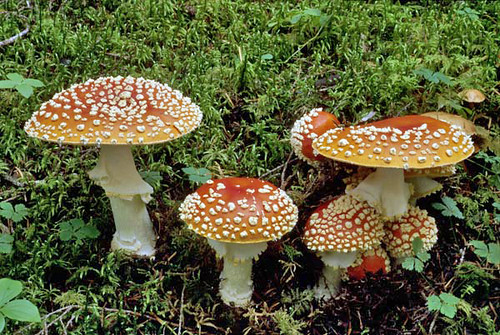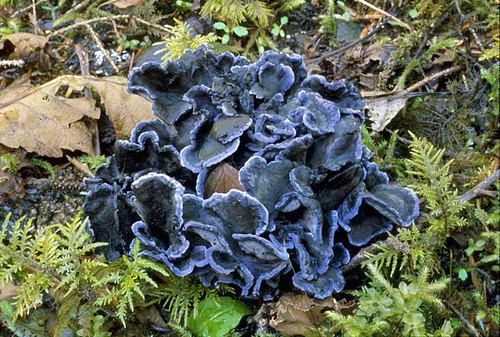
The fly agaric (Amanita muscaria) sits on the forest floor in Alaska as if it is waiting to be cast in an Alice in Wonderland movie.
Its recognizable bright red cap dotted with white warts belies their toxic nature. Although the effects vary, experts warn against eating them. In Alaska, fly agaric is generally found around birch or spruce trees and loves the northwest environment.
In another part of the forest the blue or black chanterelle (Polyozellus multiplex) bears its spores on thick, shallow folds with blunt edges and cross-veins instead of true gills. On the ground, it is a distinctive and striking mushroom, with blue-purplish to blackish caps that grow in a tightly packed, wavy edged cluster. The jury is out on its taste but it can be used as a natural dye. However, because this species is rare, potential harvesters should use restraint and let it remain in the forest.

Another mushroom found in Alaska is the shrimp russula (Russula xerampelina), probably the most frequently eaten variety of russula. They produce large stout fruitbodies with a fishy odor when mature. They have whitish stalks that stain brown when handled, and dull orange-yellow spores and gills when mature. The typical form has a reddish, maroon, or deep purple cap and various degrees of pink on the stalk, but the cap also can be green to olive to dark brown or blackish, or brownish purple.
These mushrooms and more can be found in Mushrooms of the National Forests in Alaska, a brochure about mushrooms in the southern portion of the state. In Alaska, the Tongass National Forest sits as the nation’s largest with 17 million acres followed by the Chugach National Forest with 5 million acres. The brochure offers 51 species representing the more common and interesting of those found in that area. Although the brochure includes photos, it is not intended as a stand-alone identification guide.
“Southern Alaska’s forests provide the perfect combination of moisture and host species to support an abundance of mushrooms every fall. Not only are some of them tasty and brighten the dark forest floor with ephemeral burst of colors, but many of these species are essential to forest health.”
The brochure includes an explanation the basic makeup of mushrooms, which are produced by some fungi and have a primary purpose to make and spread tiny reproductive propagules called spores. Those spores function much like seeds.
Unlike plants, fungi cannot make their own food. Mushrooms arise from the “body” of the fungus and are comprised of a network of tube-like microscopic filaments called hyphae. Hyphae grow at their tips and are able to infiltrate a wide variety of substrates such as wood, leaf litter and soil. Even leftover pizza.
People generally think of mushrooms as umbrella-shaped formations with plate-like gills on the underside of their caps. There are many shapes and sizes with spores produced in a variety of ways. Other major groups of mushrooms include chanterelles, boletes, polypores, spine-fungi, club- and coral-fungi, puffballs, jelly-fungi, cup-fungi, morels, false morels, and elfin saddles.
Fungi that produce mushrooms have many ecological roles. They are found in nearly every environment but are most prevalent in forests, playing critical roles in nutrient cycling, soil aggregation and water retention. They also are a food source for animals, including humans.
There are probably more than 40,000 to 55,000 mushroom-producing fungi in the world. A conservative estimate for the Pacific Northwest is at least 5,000. And some believe that only 15 to 40 percent of North American mushroom-fungi have been described.
Before harvesting mushrooms, please contact the supervisor’s office of the national forest or grassland you plan to visit. The brochure does include a safety checklist for mushroom hunters.
